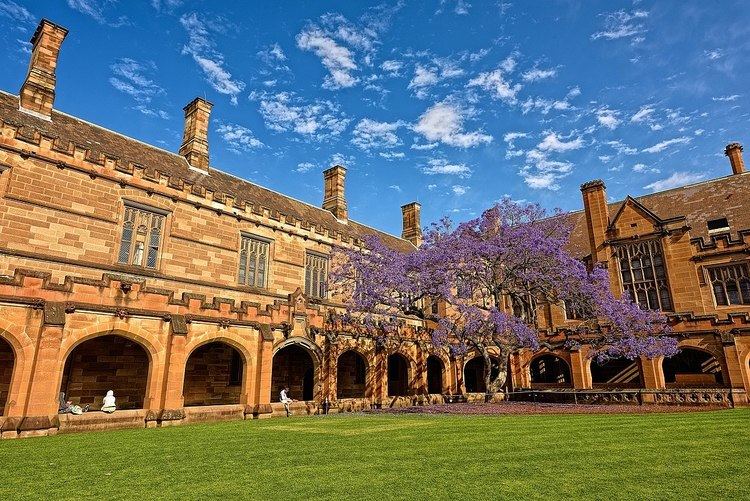 | ||
The jacaranda was a historically significant specimen of Jacaranda mimosifolia tree that stood in the south-eastern corner of the University of Sydney main quadrangle. It was first planted in 1928 by Associate Professor Eben Gowrie Waterhouse, and replaced several times in the 1930s. Blooming in late spring at the end of the academic year, it became closely associated with examination time at the university. During its life it formed the background to many events and was on the City of Sydney's Significant Tree Register. On 28 October 2016, the tree died after 88 years and fell over.
Contents
Planting
The tree was located in the corner of the quadrangle close to where Philosophy classes used to be held. It was planted by Eben Gowrie Waterhouse, who was McCaughey associate professor of German and comparative literature and also a camellia expert. His interest in horticulture and landscaping influenced the design of the gardens at the university. He is credited with turning the main quadrangle where the jacaranda grew "from an unsightly mess into a dignified area". Waterhouse continued to be engaged for many years on beautification schemes involving tree planting for the university, in the city beyond the university, as well as in other cities beyond Sydney. In an address given in Newcastle in 1936, Waterhouse said that "beautification of urban and suburban areas ranked among the finest forms of community service" and that in tree planting, the preservation of trees and the creative work were both important. In 1966 he received a gold medal from the Royal Horticultural Society, London.
Stories about the difficulty of establishing the tree circulated for many years. Students were blamed for several failed efforts after young trees were ripped out and frustrated Committee members passed "motions deploring the actions of 'irresponsible vandals'". Vandalism concerning the jacaranda was included in newspaper reports as late as 1939. An alternative view is that staff stole young trees for their own gardens. Eventually, the planting succeeded and over its life, the jacaranda grew to a width of 18 metres, becoming both "grand" and "iconic".
Life
Sydney University's jacaranda formed the backdrop to many public and private events that took place in the quadrangle, including graduations and weddings. In the opinion of Mark Scott, it was "the most famous tree in education". The university's landscape and grounds manager said "I don't think the quadrangle would be the space it is without that tree."
The tree was well-loved in spite of its association with the examination period in November when jacarandas all over Sydney come into flower. Accepted wisdom was that exam failure was inevitable for a student who had not yet begun to study by the time its purple blooms appeared.
In 2005 the jacaranda was added to the list of historic or environmentally significant trees in the City of Sydney as "one of Sydney’s best known significant trees". It was known as "a living asset". In 2012, the city's chief arborist placed it in the Register's Top 10. The trees on the Register are selected on the basis of their "historical, cultural, social, ecological or outstanding visual and aesthetic appeal". Other varieties of tree on the Register near to the university include Moreton Bay figs in Alexandria Park, Alexandria and Observatory Hill; Brush box trees in Avenue Road, Glebe; Washington palms in Farrer Place, Sydney; Plane trees on Bourke Street, Surry Hills; and Dragon's blood trees in Cook and Phillip Park.
Death
In 2016 the tree died after 88 years, possibly of ganoderma fungus, and fell over on October 28. It was cut up and removed the following day. The university issued a press release reminding students that the tree had begun to bloom and wished "them all well for their final weeks of study for 2016".
The university had been advised two years earlier that the tree was nearing the end of its life. Aware of its significance, the university administration had taken cuttings in 2014 and maintained three "emergency" specimens. The clones that resulted will enable it to be replaced with genetically identical stock. The university also intends to plant a native tree alongside the replacement jacaranda – potentially a yellow box or flame tree – in recognition of the Gadigal people on whose traditional lands the university is located.
